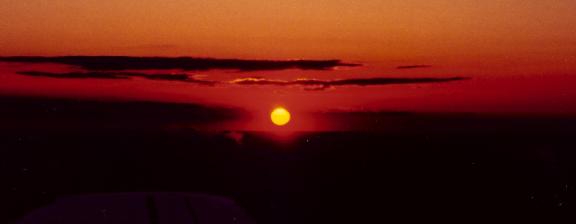SKYLIGHTS

Photo of the Week.. A golden sun shines from
below the formal horizon, the deep red sunset compliments of
the Sun being viewed from high
altitude from an airplane.
Astronomy news for the week starting Friday, March 15, 2002.
The next Skylights will appear on Saturday, March 23. The Moon
grows from near new through its crescent phase, reaching first
quarter the night of Thursday, March 21. The night of Sunday the
17th, the Moon will pass four degrees below (southeast of) reddish
Mars. Near Mars lies the barely-visible Comet Ikeya-Zhang. As the
lunar orbit moves the Moon a bit north toward and then across the
ecliptic, the Moon will be seen due west of Saturn the evening of
Tuesday, the 19th, and then to the west and a bit north of Jupiter
the night of Thursday, the 21st. The night of the 19th is
especially attractive because of Saturn's current location to the
north of Aldebaran and the Hyades cluster of Taurus. But Jupiter's location
among the bright stars of Gemini will make the 21st a fine sight as
well. And speaking of fine sights, be sure to admire brilliant
Venus, which is now obvious in western twilight.
The region around Saturn contains more than meets the eye. On
Tuesday the 19th, Saturn will be just a bit north of the Vesta,
providing a fine guide to the sky's brightest asteroid, which under
ideal circumstances is just visible to the naked eye. A small
telescope will show it readily. Fourth to be discovered in the
early 19th century, Vesta is the third largest of asteroids, with
a diameter of around 300 miles (500 kilometers).
The big news of the week is of planet Earth, as we watch the Sun pass the Vernal Equinox in Pisces on Wednesday, March 20 at 1:16 PM Central
Standard Time (2:16 PM EST, 11:16 AM PST). At that moment the Sun
will cross over the celestial equator into the northern hemisphere,
beginning northern hemisphere spring and southern hemisphere
autumn. The axis of the Earth will be exactly perpendicular to the
line to the Sun, the Sun will be overhead at the Earth's equator,
and the Sun will technically rise at the north pole and set at the
south pole. In fact, because of the half-degree solar diameter and
the lofting effect of refraction in the Earth's atmosphere, the Sun
will actually rise at the pole a couple days before, and will
linger a bit after at the southern pole.
While spring ascends, and the winter stars move off to the west, we
still have plenty of time to admire them. In early evening,
brilliant Sirius of Canis Major stands to the south.
Below and to the east floats the great ship Argo that honors Jason and his quest for the Golden
Fleece. The constellation is so large that it was broken into
three parts. The bright stars just below Canis Major are part of
Puppis, the Stern, while the stars
of Vela the Sails flap way to the
southeast. Below the horizon for viewers in the mid latitudes lies
Carina, the Hull, visible from the
southern US and down, its luminary the great star Canopus.







